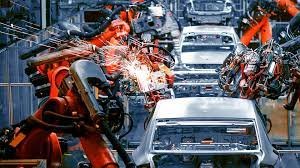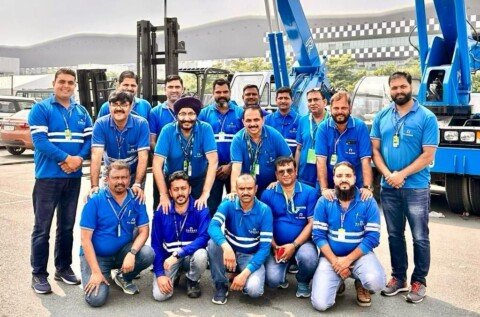Warehouse automation is expected to become an increasingly desirable option to the manual alternative over the next few years. That directly indicates a high likelihood of investment in these technologies. So, broad-based investment activity is expected. Latest findings indicate that changes in the operating environment; such as labor costs, labor shortages, and increased throughput requirements; are the primary influential factors. Meanwhile, industry experts also indicate that advancements in automation, such as lower costs and scalability improvements, are supporting factors.
Upamanyu Borah
The automation of activities can enable productivity growth and other benefits at both the level of individual process and businesses, as well as at the level of entire economies, where productivity acceleration is sorely needed, especially as the share of the working age population declines in many countries. At a microeconomic level, businesses everywhere will have an opportunity to capture benefits and achieve competitive advantage from automation technologies, not just from labour cost reductions, but also from performance benefits such as increased throughput, higher quality, and decreased downtime. At a macroeconomic level, automation could raise productivity growth on a global basis by as much as 0.8 to 1.4 per cent annually.
For warehouse operators and logistics companies, distribution, manufacturing and supply chain processes are about to change very quickly.
According to Adobe’s Digital Intelligence Briefing, only about 15% of businesses have adopted AI today, however, over the next 12 months, this number is expected to rise to 31%. Judging by this expected increase in the application of AI, automation is here to stay. In the world of warehouse management software, this means considering the benefits of automated warehouse systems and warehouse automation.
Automated warehouse systems has the potential to eliminate about 75 per cent of the time wasted by walking around a facility, picking up tools and parts, and improved sensors and analytics could raise the proportion of predictive maintenance, which is less costly than reactive maintenance. Automation could enable managers to monitor all maintenance from a command centre, which would reduce variability, and ensure better data collection.
“Walking time is one of the major issues in warehouses, which impacts the efficiency of workers and has proven to be ergonomically inefficient. In addition to the opportunity cost, the bigger challenge posed by walking time is scalability. Customers are unable to meet the need of increased throughput and tighter delivery time (same day, etc.), as adding more people for picking is limited due to space constraints,” says K Nandakumar, General Manager, Honeywell Safety and Productivity Solutions–India.
Increasing Speed, Decreasing Cost
Warehouses struggle with a number of costly issues that can hold them back from achieving their true potential. One of the biggest pain points warehousing operations face is the need to improve productivity and efficiency.
Firstly, by automating picking and product transportation processes, human employees can be utilised to solve issues robots cannot tackle like planning and management. Robotics can be scaled up and down as time progresses. If your operation needs to increase speed and accuracy to meet your requirements, integrated robotics and automation can handle the extra workload without creating an unsafe workplace.
“With human picking, there is also a challenge of increasing load density beyond a certain point,” points out Nandakumar. “With more SKUs getting added every day, companies are keeping multiple SKUs in the same bin which in turn adds an extra step in the picking process, thereby reducing overall efficiency. The combination of automation with human skill can improve speed and efficiency to enhance overall customer experience.”
Another valuable benefit of warehouse automation technology is cost-cutting across the board. It is true that integrating automation systems isn’t cheap, but they quickly start to pay for themselves. Although the upfront cost of adopting and implementing automation systems isn’t cheap, it pays for itself in the long run. Paying manual labor quickly eclipses the costs of using automation technology. In fact, a recent experiment comparing manual labour to automation has shown that over two years manual labour carried a cost of US$900,000 while automation was significantly lower at US$540,000. That’s the ROI for a fully automated operation!
This is especially true for retailers who have to deal with overtime during the busy holiday seasons. When it gets close to the biggest order days of the year, overtime usage can spike as employees log additional hours to help keep up with the busy season. With warehouse automation in place, however, you can keep your machines running for a long time without incurring an extra cost. After all, machines don’t have to worry about holiday spending money.
Today, the need for efficient warehouse operations has only grown with the rise of e-commerce. Warehouses play an important role in the relationship between companies and their customers, and inefficient operations can negatively impact customer satisfaction.
Companies are turning to warehouse automation in response. The right level of automation and autonomy enables faster, safer and more efficient day-to-day operations. It cuts costs and improves delivery times for a faster, leaner, and more scalable and sustainable operation. The 24×7 digital economy we operate in, the impact of COVID-19 on supply chains, and the increasing consumer demand for instant, sustainable commerce are forcing companies towards a greater strategic shift. Companies must have the foresight to visualize the true, long-term potential of the right technology investments.
“The e-commerce sector is a significant employer,” says Nandakumar. “Robotics technology has advanced in a manner that it can complement humans in the e-commerce industry. Goods-to-person robotic technology creates an optimum blend between robots and humans to make the order picking workflow scalable. The machines are also monitored by IoT sensors, which results in early prediction of issues and removes unnecessary downtime. Improved productivity and performance often result in higher job satisfaction—an important component of talent retention.”
“The rapid emergence of e-commerce as a mainline business vertical in the recent years has expedited the process of embracing automation at a large scale,” agrees Asim Behera, Senior Director- Automation at Coupang—one of the largest e-commerce companies in Asia.
“E-commerce, and specifically, grocery delivery is changing the logistics landscape. E-commerce is all about tremendous speed of delivery and to add to it the millions of SKUs that it offers as choice to customers. To achieve the committed Service Level Agreement (SLA) to customers, each of the processes, which begins when a customer clicks ‘buy now’ need to be done in the quickest way possible,” says Behera.
“So, in the warehouse, there is a lot of need for order picking, sorting, packing technologies. In the ‘other’ category, the need for truck routing software, last-mile delivery where various sophisticated technologies such as drones, Autonomous Mobile Robots (AMRs) are getting popular as an idea,” he adds.
“It’s a paradox that wage rates and operational costs are increasing while the customers are demanding price reductions from the logistics companies year-on-year,” observes Mudit Gupta, Co-founder, PackSo Technology—a B2B platform for buying of pallets and other packaging products which bridges the gap between buyers and seller.
Gupta says, “The only solution to match the two is by going for automation. Automation can be vide investment in technology, in handling of products or through use of robotics in all aspects of operations. Benefits of automation completely outweighs the investment.”
“The answer to this lies in the end-to-end automation capabilities, substantiated by the unprecedented rise of robotics in the logistics space,” puts across Nanadakumar.
“Inventory management, material handling, resource allocation, and retail strategy have been optimised to a large extent, with self-regulatory mechanisms now addressing operational shortcomings. Technologies like Automated Storage and Retrieval System (AS/RS) help resolve the growing need for load density by vertically utilising warehouse space and increasing the picking workflow productivity by 6X to 10X from our baseline today.”
“Honeywell has a robust portfolio of AS/RS. We have Shuttle and Crane AS/RS which can help solve for both tote and pallet level loads.”
Honeywell Crane AS/RS are capable of transporting loads of up to 1,500 kg with capability to storage at 25m height.
Honeywell AS/RS Shuttle System is used in inventory storage, buffer, and fulfilment applications. These are highly flexible systems that provide quick access to cartons, totes and trays for a reduced warehouse footprint.
The changing fulfilment paradigm for 3PLs
Third-party logistics providers (3PLs) excel at warehouse operations. They do it fast. They do it right. They are the experts. This is the service that their customers pay for. But, does part of a 3PLs’ ability to quickly fulfil orders fall on their customer’s shoulders? Yes. The speed at which a 3PL can pick, pack and ship orders is often dependent on the lead time with accurate order data that they have. Without it, even the very best 3PL is at the mercy of their customer’s poor data practices. Today, as consumer expectations for rapid fulfilment increase, a 3PL’s speed further increases. 3PLs are doing everything they can to pick, pack and ship more orders faster than ever. Automation makes this possible. From WMS to EDI to robotics, warehouses of today are continually advancing to speed 3PL fulfilment.
“Third-party logistics entities and warehouse operators needn’t dramatically change their processes to take advantage of robots and automation. However, they do have to “think outside the cart”, with the ever-so-popular motorided plant vehicles now turning obsolete,” insights Nandakumar.
“At Honeywell, we provide highly intelligent AMRs that can sizably augment workers’ productivity, thereby adding a new dimension altogether to the process flow.”
Recently, Honeywell announced its latest innovation in robotic technology designed to help warehouses and distribution centres automate the manual process of unloading pallets, reducing the operational risks of potential injuries and labor shortages.
Driven by sophisticated machine learning and advances in perception and gripping technologies, Honeywell’s Smart Flexible Depalletiser minimises the need for manual labour to break down pallet loads – roles that carry risk of injury to labour, experience high turnover and are currently difficult to staff.
The depalletiser’s articulated robotic arm is guided by advanced vision and perception technologies, which allow cases to be picked from a single- or mixed-SKU pallet on a fixed or mobile location. The latest computer vision technology identifies the exact location of every case on the pallet, while perception software automatically recognises a wide variety of packaging. This technology allows for seamless handling of a continuous flow of pallets in any sequence without requiring any pre-programming or operator intervention.
The advanced machine learning and motion planning optimises the movements of the robotic arm to ensure maximum picking speed and efficiency. The control logic also senses the weight of each item as the robot lifts it and automatically updates its gripping response to transfer each product securely and effectively. The more the solution picks, the more it learns and continues to improve in quickly and efficiently unloading pallets.
The robot can work in conjunction with pallet conveyance autonomous mobile robots, enabling continuous operation of the system while providing the flexibility to stage pallets and empty stacks virtually anywhere the robot is capable of traveling.
Nandakumar informs that Honeywell is enabling functions like true omnichannel fulfilment which is in increasing demand, and difficult or impossible to accomplish with other approaches. The solutions, he says, delivers compelling, hard economic benefits to warehouse operators today.
“As we shift to a more connected and streamlined industry, we are seeing more warehouses adopt this new standard for productivity, economic success, and competitive differentiation,” Nandakumar adds.
“Shortage of manpower, increase in demand for throughput within the same space, increased efficiency, demand for reduction in prices, centralised distribution with advent of GST, growth of e-commerce with the need to manage small parcels are some of the factors which have already created the need and propelled the growth of automation in logistics, distribution and warehousing space,” explains Gupta.
“Migration of labour in the COVID era was also a wake-up call for the manufacturers and 3PL companies forcing them to rethink on their plans. Major players are rushing in to meet the requirements of their own or their customers in order to provide world class experience without increase in the costs.”
Therefore, for companies that want to scale, venture into new markets, and create positive customer experiences, partnering with 3PLs offers some desirable perks. For example, these external partners provide logistical expertise and an extensive network of supply chain resources.
To successfully partner with 3PLs, companies/retailers also need to also connect disparate systems and applications together. Integration bridges any gaps to automate business processes.
First and foremost is to address the most important business processes and identify which areas need to be in sync. Here’s a potential integration roadmap for some inspiration:
- Order Fulfilment: This includes new sales orders, order cancellations, shipment confirmations, and more.
- Inventory Visibility: Aligning storefront and enterprise resource planning (ERP) software with the various warehouses that exists between the company and its 3PL providers.
- Item or Product Updates: 3PLs should stay up to date with the company’s item catalog, including the correct SKUs.
- Returns Processing: The company should sync its return merchandise authorisation (RMA) with its 3PLs.
- Inbound Shipments: Inbound shipment requests, purchase order (PO) imports and exports, and shipment receipts are examples of what needs to line up with the company 3PLs.
Final Thoughts
The pandemic has led to a surge in several warehouse automation trends. Warehouse operators/3PLs are now open to introducing robotics and automation to remain competitive. Typically, flexible robotics solutions offer a wide array of benefits across diverse work streams.
Speaking of Honeywell’s AMRs, the key operational advantages that Nandakumar highlights are:
- Cloud robotics platform that enables on-demand automation within the warehouse.
- 100,500 and 1,500 kg payload robot models that can autonomously transport virtually any item, from parts to pallets.
- Deployment in hours with minimal infrastructural changes.
- Returned or refurbished items can be received and manually sorted into bins on AMR carts.
- Available interfaces can integrate with a variety of external systems, from hand scanners to programmable logic controllers (PLCs) to warehouse management systems (WMS), Momentum WES and warehouse control systems (WCS).
- The broadest range of AMRs in the industry, available for applications such as piece/case/pallet picking, order consolidation and kitting, replenishment and cross-docking.
The good news is that for those committed to building automated warehouse systems, there are plenty of options. The downside is that much of the technology on the hardware side is still fairly expensive to install and integrate. While, it’s certainly true that things like drones and robotics can save a company sizable amounts of cash, companies have got to be willing to invest heavily first.
Smaller companies and those on a budget are advised to start with cloud systems if they haven’t already. There are many cloud-based systems out there that can help harness the power of automation while providing helpful advantages like better network security and scalability.
“Initial investment required for automation remains the key challenge for majority of companies, with capital becoming scarce and dipping profits in the COVID era it is a larger challenge. Another factor is the risk taking ability and conviction of an organisation, any oversight during implementation of warehouse automation can have catastrophic supply chain disruptions. Implementation is a continuous and step by step process which has to be project managed with focus from the C-level executives of the organisation,” explains Gupta.
For Behera, the biggest issue will be getting everyone in the value chain to embrace the automation as an enabler rather than as a threat. Also, as different automation projects are taken up, a holistic master-plan has to be first created.”
For example, Behera says, the Enterprise Resource Planning (ERP) has to be in sync with Order Management System (OMS) and the Warehouse Management System (WMS). “The various automation sub-systems need to seamlessly integrate with the Supervisory Control and Data Acquisition (SCADA). The network that keeps them connected should have various fail safe redundancies built in.”







